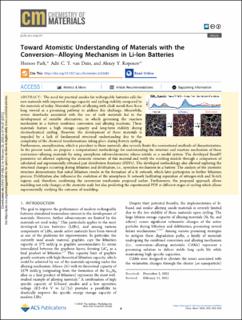| dc.description.abstract | The need for practical anodes for rechargeable batteries calls for new materials with improved storage capacity and cycling stability compared to the materials of today. Materials capable of alloying with alkali metals have been long viewed as a promising pathway to address this challenge. Meanwhile, severe drawbacks associated with the use of such materials led to the development of suitable alternatives, in which governing the reaction mechanism in a battery combines conversion and alloying reactions. These materials feature a high storage capacity and long-term stability during electrochemical cycling. However, the development of these materials is impeded by a lack of fundamental structural understanding due to the complexity of the chemical transformations taking place during battery cycling. Furthermore, amorphization, which is prevalent in these materials, also severely limits the conventional methods of characterization. In the present work, we propose a computational methodology for understanding the structure and reaction mechanism of these conversion–alloying materials by using amorphous substoichiometric silicon nitride as a model system. The developed ReaxFF parameter set allowed exploring the atomistic structure of this material and verify the resulting models through a comparison of calculated and experimentally obtained pair distribution functions (PDFs). The developed methodology also allowed exploring the structural changes occurring during lithiation and delithiation, i.e., operation mechanism in a battery. The analysis of the atomistic structure demonstrates that initial lithiation results in the formation of a Si network, which later participates in further lithiation process. Delithiation also influences the evolution of the amorphous Si network facilitating separation of nitrogen-rich and Si-rich regions and, therefore, confirming the conversion mechanism proposed earlier. Furthermore, the proposed approach allows modeling not only changes at the atomistic scale but also predicting the experimental PDF at different stages of cycling which allows experimentally verifying the outcome of modeling. | en_US |

